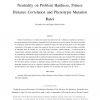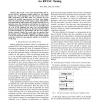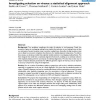111
Voted
TEC
2012
13 years 3 months ago
2012
Kimura’s neutral theory of evolution has inspired researchers from the evolutionary computation community to incorporate neutrality into Evolutionary Algorithms (EAs) in the hop...
93
Voted
CEC
2010
IEEE
14 years 10 months ago
2010
IEEE
Abstract-- We present a case study demonstrating that using the REVAC parameter tuning method we can greatly improve the `world champion' EA (the winner of the CEC2005 competi...
105
click to vote
EC
2006
15 years 20 days ago
2006
The error threshold of replication is an important notion of the quasispecies evolution model; it is a critical mutation rate (error rate) beyond which structures obtained by an e...
107
click to vote
BMCBI
2008
15 years 23 days ago
2008
Background: Two problems complicate the study of selection in viral genomes: Firstly, the presence of genes in overlapping reading frames implies that selection in one reading fra...
GECCO
2004
Springer
15 years 6 months ago
2004
Springer
Traditionally, the mutation rates of genetic algorithms are fixed or decrease over the generations. Although it seems to be reasonable for classical genetic algorithms, it may not...
100
Voted
EVOW
2005
Springer
15 years 6 months ago
2005
Springer
Non-random mating seems to be the norm in nature among sexual organisms. A common mating criteria among animals is assortative mating, where individuals mate according to their phe...
102
click to vote
RECOMB
2002
Springer
16 years 29 days ago
2002
Springer
We introduce a model of DNA sequence evolution which can account for biases in mutation rates that depend on the identity of the neighboring bases. An analytic solution for this c...
104
Voted
RECOMB
2004
Springer
16 years 29 days ago
2004
Springer
We study a situation that arises in the somatic evolution of cancer. Consider a finite population of replicating cells and a sequence of mutations: type 0 can mutate to type 1, wh...



